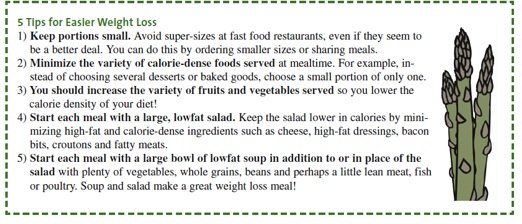Controlling Calories
At the North American Association for the Study of Obesity annual meeting in Ft. Lauderdale, Fla., in October 2003, two interesting weight loss studies from Dr. Barbara Rolls (author of Volumetrics) laboratory at Penn State were reported. These studies examined how dietary factors interact to influence people’s calorie intake.In general, it has been shown that some factors tend to increase ad libitum* calorie intake. These include:
- offering larger portions.
- increasing the calorie density** of the foods offered.
- offering a greater variety of foods.
The food industry in America is offering people an increasing variety of calorie-dense foods and offering these rich foods in larger and larger portions.Dr. Rolls’ first study examined the impact of starting a meal with or without a salad on how many total calories would be consumed at that meal. In general, offering people a greater variety of things to eat tends to increase their calorie intake. In this study, subjects were offered a small or a large salad 20 minutes before getting a pasta entr?e. The salads offered varied in calorie density. One version had a fairly high calorie density due to the addition of extra cheese and a fattier dressing. Another version used a lowfat dressing and had a much lower calorie density. The subjects were required to finish the salad but were then free to eat as much as they wanted of a pasta entree. Here is what happened:Compared to when no salad was offered, the subjects consumed more total calories at the meal when they ate either the small or large calorie-dense salad first.However, when the subjects consumed the large but low-calorie-dense salad before the pasta entree, the average calorie intake for the entire meal (salad plus pasta) was significantly less than when they just ate the pasta with no salad.The take-home lesson here should be clear. If weight loss is the goal, then eating a large, lowfat salad before a meal will likely cause a reduction in the ad libitum calorie intake for the whole meal. However, if that salad is loaded with cheese, bacon bits, and croutons and has a large amount of a fatty salad dressing, then total calories consumed at the meal will likely be much higher compared to skipping salad.The second study examined how the portion size offered interacted with the calorie density of the foods. Both portion size and calorie density impacted ad libitum calorie intake. The more-calorie-dense meal had 794 calories per pound and the less-calorie-dense meal had 567 calories per pound. Despite the difference in calorie density, the low- and high-calorie-dense meals had the same ratio of fat, protein and carbohydrate, and both had a similar palatability rating. Both the higher- and lower-calorie-dense meals were offered to subjects in three different portion sizes varying from 1.1 pounds up to nearly 2 pounds. However, the subjects were free to eat as much or as little as they wanted of each meal. The subjects also consumed as much as they wanted of standard meals offered at breakfast and dinner in the same laboratory setting throughout the study.Here is what they found: When the subjects were offered the largest portion of the entree, which also had the higher calorie density, they consumed 56 percent more calories on average than when they were offered the smallest portion of the entree with the lower calorie density. Furthermore, despite consuming considerably more calories at the test meal when offered the largest portion of the more-calorie-dense entree, the amounts of calories consumed at dinner were not reduced. As a result, calorie intake for the entire day increased when people were offered larger portions of more-calorie-dense foods at lunch.

The bottom line:The results suggest that the current trend in the U.S. for Americans to be overweight or obese is likely due in part to the growing popularity of calorie-dense, super-sized meals at fast-food restaurants.Footnotes:* ad libitum calorie intake means at will; allow people to eat as much as they want** calorie density is the concentration of calories in a given weight of food. For example, calories per pound.By James Kenney, PhD, RD, LD, FACN.